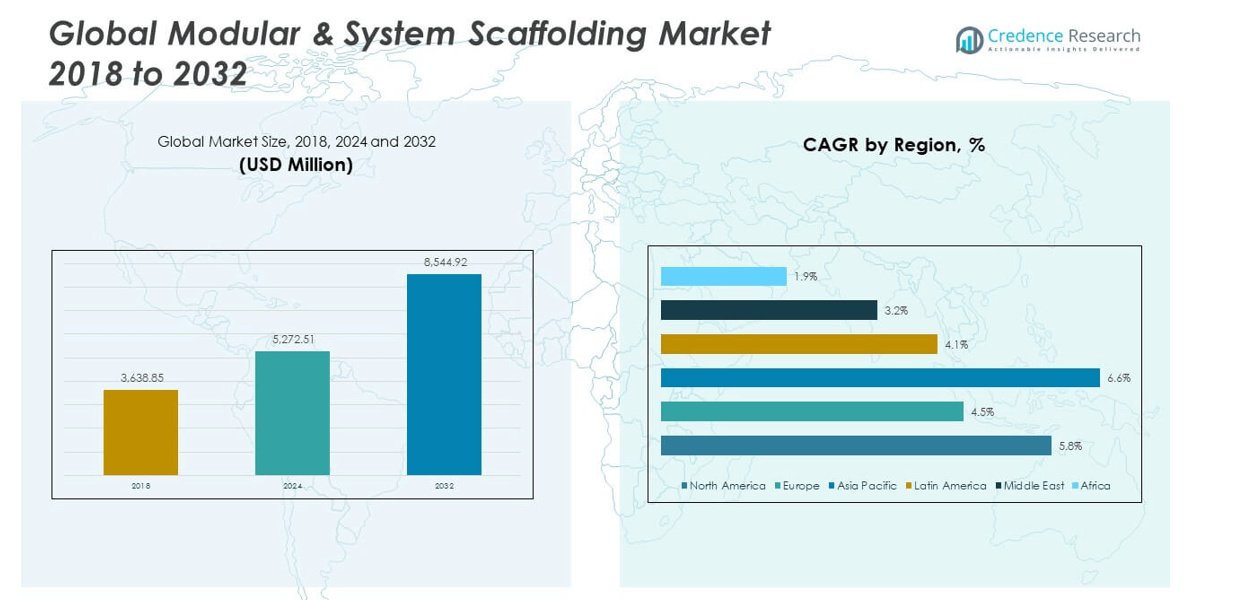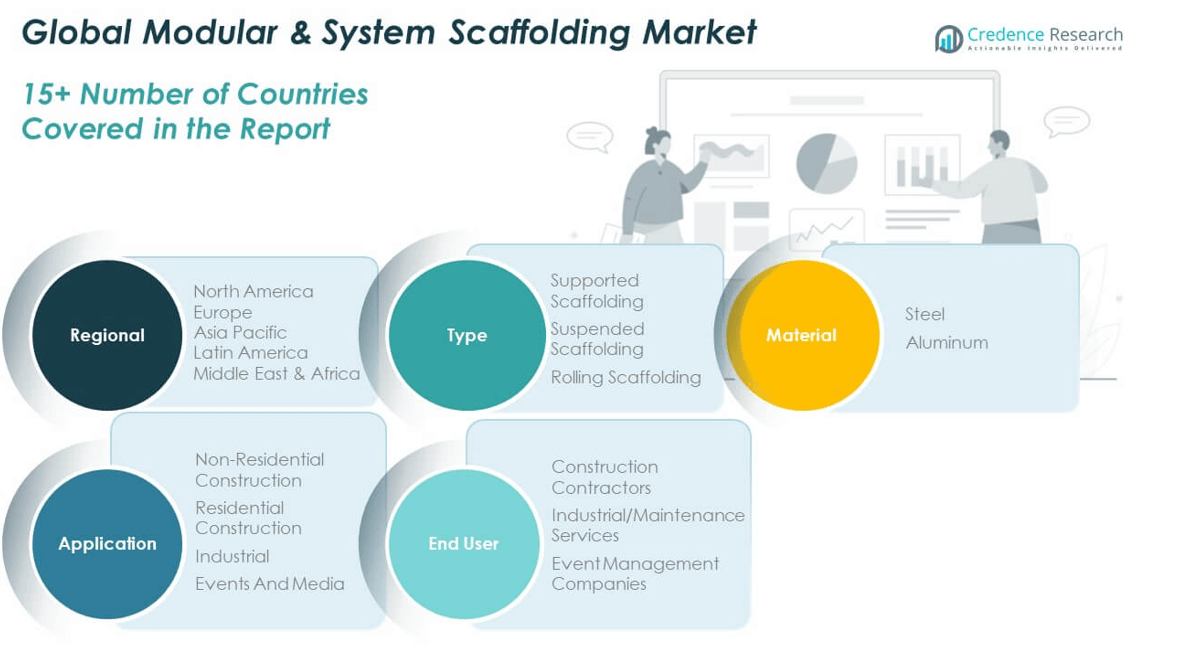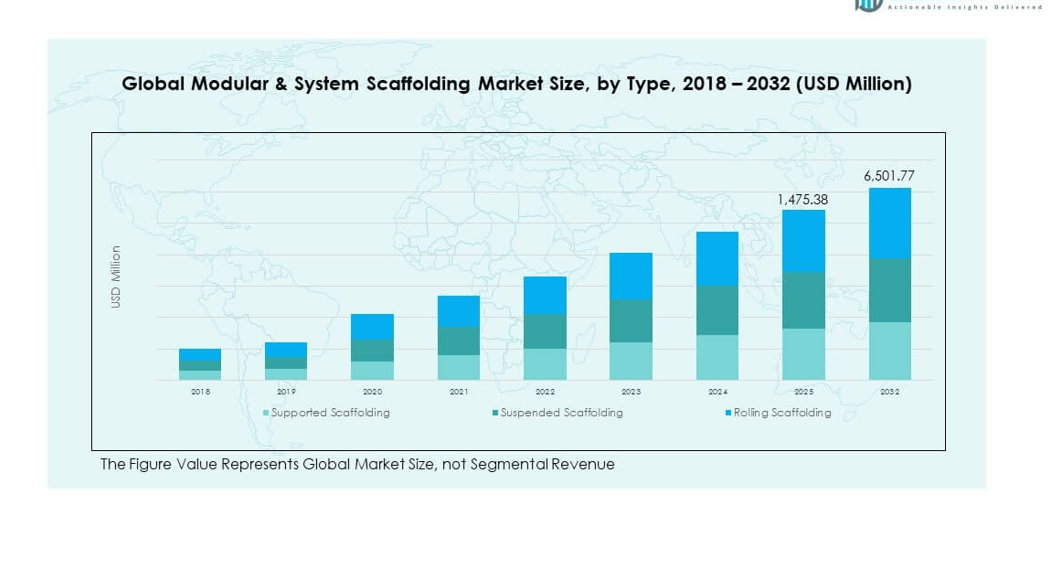CHAPTER NO. 1: GENESIS OF THE MARKET
1.1 Market Prelude – Introduction & Scope
1.2 The Big Picture – Objectives & Vision
1.3 Strategic Edge – Unique Value Proposition
1.4 Stakeholder Compass – Key Beneficiaries
CHAPTER NO. 2: EXECUTIVE LENS
2.1 Pulse of the Industry – Market Snapshot
2.2 Growth Arc – Revenue Projections (USD Million)
2.3. Premium Insights – Based on Primary Interviews
CHAPTER NO. 3: MODULAR & SYSTEM SCAFFOLDING MARKET FORCES & INDUSTRY PULSE
3.1 Foundations of Change – Market Overview
3.2 Catalysts of Expansion – Key Market Drivers
3.2.1 Momentum Boosters – Growth Triggers
3.2.2 Innovation Fuel – Disruptive Technologies
3.3 Headwinds & Crosswinds – Market Restraints
3.3.1 Regulatory Tides – Compliance Challenges
3.3.2 Economic Frictions – Inflationary Pressures
3.4 Untapped Horizons – Growth Potential & Opportunities
3.5 Strategic Navigation – Industry Frameworks
3.5.1 Market Equilibrium – Porter’s Five Forces
3.5.2 Ecosystem Dynamics – Value Chain Analysis
3.5.3 Macro Forces – PESTEL Breakdown
3.6 Price Trend Analysis
3.6.1 Regional Price Trend
3.6.2 Price Trend by Product
CHAPTER NO. 4: KEY INVESTMENT EPICENTER
4.1 Regional Goldmines – High-Growth Geographies
4.2 Product Frontiers – Lucrative Product Categories
4.3 Application Sweet Spots – Emerging Demand Segments
CHAPTER NO. 5: REVENUE TRAJECTORY & WEALTH MAPPING
5.1 Momentum Metrics – Forecast & Growth Curves
5.2 Regional Revenue Footprint – Market Share Insights
5.3 Segmental Wealth Flow – Type & Application Revenue
CHAPTER NO. 6: TRADE & COMMERCE ANALYSIS
6.1. Import Analysis by Region
6.1.1. Global Modular & System Scaffolding Market Import Revenue By Region
6.2. Export Analysis by Region
6.2.1. Global Modular & System Scaffolding Market Export Revenue By Region
CHAPTER NO. 7: COMPETITION ANALYSIS
7.1. Company Market Share Analysis
7.1.1. Global Modular & System Scaffolding Market: Company Market Share
7.2. Global Modular & System Scaffolding Market Company Revenue Market Share
7.3. Strategic Developments
7.3.1. Acquisitions & Mergers
7.3.2. New Product Launch
7.3.3. Regional Expansion
7.4. Competitive Dashboard
7.5. Company Assessment Metrics, 2024
CHAPTER NO. 8: MODULAR & SYSTEM SCAFFOLDING MARKET – BY TYPE SEGMENT ANALYSIS
8.1. Modular & System Scaffolding Market Overview by Type Segment
8.1.1. Modular & System Scaffolding Market Revenue Share By Type
8.2. Supported Scaffolding
8.3. Suspended Scaffolding
8.4. Rolling Scaffolding
CHAPTER NO. 9: MODULAR & SYSTEM SCAFFOLDING MARKET – BY MATERIAL SEGMENT ANALYSIS
9.1. Modular & System Scaffolding Market Overview by Material Segment
9.1.1. Modular & System Scaffolding Market Revenue Share By Material
9.2. Steel
9.3. Aluminum
CHAPTER NO. 10: MODULAR & SYSTEM SCAFFOLDING MARKET – BY APPLICATION SEGMENT ANALYSIS
10.1. Modular & System Scaffolding Market Overview by Application Segment
10.1.1. Modular & System Scaffolding Market Revenue Share By Application
10.2. Non-Residential Construction
10.3. Residential Construction
10.4. Industrial
10.5. Events And Media
CHAPTER NO. 11: MODULAR & SYSTEM SCAFFOLDING MARKET – BY END USER SEGMENT ANALYSIS
11.1. Modular & System Scaffolding Market Overview by End User Segment
11.1.1. Modular & System Scaffolding Market Revenue Share By End User
11.2. Construction Contractors
11.3. Industrial/Maintenance Services
11.4. Event Management Companies
CHAPTER NO. 12: MODULAR & SYSTEM SCAFFOLDING MARKET – REGIONAL ANALYSIS
12.1. Modular & System Scaffolding Market Overview by Region Segment
12.1.1. Global Modular & System Scaffolding Market Revenue Share By Region
12.1.2. Regions
12.1.3. Global Modular & System Scaffolding Market Revenue By Region
12.1.4. Type
12.1.5. Global Modular & System Scaffolding Market Revenue By Type
12.1.6. Material
12.1.7. Global Modular & System Scaffolding Market Revenue By Material
12.1.8. Application
12.1.9. Global Modular & System Scaffolding Market Revenue By Application
12.1.10. End User
12.1.11. Global Modular & System Scaffolding Market Revenue By End User
CHAPTER NO. 13: NORTH AMERICA MODULAR & SYSTEM SCAFFOLDING MARKET – COUNTRY ANALYSIS
13.1. North America Modular & System Scaffolding Market Overview by Country Segment
13.1.1. North America Modular & System Scaffolding Market Revenue Share By Region
13.2. North America
13.2.1. North America Modular & System Scaffolding Market Revenue By Country
13.2.2. Type
13.2.3. North America Modular & System Scaffolding Market Revenue By Type
13.2.4. Material
13.2.5. North America Modular & System Scaffolding Market Revenue By Material
13.2.6. Application
13.2.7. North America Modular & System Scaffolding Market Revenue By Application
13.2.8. End User
13.2.9. North America Modular & System Scaffolding Market Revenue By End User
13.3. U.S.
13.4. Canada
13.5. Mexico
CHAPTER NO. 14: EUROPE MODULAR & SYSTEM SCAFFOLDING MARKET – COUNTRY ANALYSIS
14.1. Europe Modular & System Scaffolding Market Overview by Country Segment
14.1.1. Europe Modular & System Scaffolding Market Revenue Share By Region
14.2. Europe
14.2.1. Europe Modular & System Scaffolding Market Revenue By Country
14.2.2. Type
14.2.3. Europe Modular & System Scaffolding Market Revenue By Type
14.2.4. Material
14.2.5. Europe Modular & System Scaffolding Market Revenue By Material
14.2.6. Application
14.2.7. Europe Modular & System Scaffolding Market Revenue By Application
14.2.8. End User
14.2.9. Europe Modular & System Scaffolding Market Revenue By End User
14.3. UK
14.4. France
14.5. Germany
14.6. Italy
14.7. Spain
14.8. Russia
14.9. Rest of Europe
CHAPTER NO. 15: ASIA PACIFIC MODULAR & SYSTEM SCAFFOLDING MARKET – COUNTRY ANALYSIS
15.1. Asia Pacific Modular & System Scaffolding Market Overview by Country Segment
15.1.1. Asia Pacific Modular & System Scaffolding Market Revenue Share By Region
15.2. Asia Pacific
15.2.1. Asia Pacific Modular & System Scaffolding Market Revenue By Country
15.2.2. Type
15.2.3. Asia Pacific Modular & System Scaffolding Market Revenue By Type
15.2.4. Material
15.2.5. Asia Pacific Modular & System Scaffolding Market Revenue By Material
15.2.6. Application
15.2.7. Asia Pacific Modular & System Scaffolding Market Revenue By Application
15.2.8. End User
15.2.9. Asia Pacific Modular & System Scaffolding Market Revenue By End User
15.3. China
15.4. Japan
15.5. South Korea
15.6. India
15.7. Australia
15.8. Southeast Asia
15.9. Rest of Asia Pacific
CHAPTER NO. 16: LATIN AMERICA MODULAR & SYSTEM SCAFFOLDING MARKET – COUNTRY ANALYSIS
16.1. Latin America Modular & System Scaffolding Market Overview by Country Segment
16.1.1. Latin America Modular & System Scaffolding Market Revenue Share By Region
16.2. Latin America
16.2.1. Latin America Modular & System Scaffolding Market Revenue By Country
16.2.2. Type
16.2.3. Latin America Modular & System Scaffolding Market Revenue By Type
16.2.4. Material
16.2.5. Latin America Modular & System Scaffolding Market Revenue By Material
16.2.6. Application
16.2.7. Latin America Modular & System Scaffolding Market Revenue By Application
16.2.8. End User
16.2.9. Latin America Modular & System Scaffolding Market Revenue By End User
16.3. Brazil
16.4. Argentina
16.5. Rest of Latin America
CHAPTER NO. 17: MIDDLE EAST MODULAR & SYSTEM SCAFFOLDING MARKET – COUNTRY ANALYSIS
17.1. Middle East Modular & System Scaffolding Market Overview by Country Segment
17.1.1. Middle East Modular & System Scaffolding Market Revenue Share By Region
17.2. Middle East
17.2.1. Middle East Modular & System Scaffolding Market Revenue By Country
17.2.2. Type
17.2.3. Middle East Modular & System Scaffolding Market Revenue By Type
17.2.4. Material
17.2.5. Middle East Modular & System Scaffolding Market Revenue By Material
17.2.6. Application
17.2.7. Middle East Modular & System Scaffolding Market Revenue By Application
17.2.8. End User
17.2.9. Middle East Modular & System Scaffolding Market Revenue By End User
17.3. GCC Countries
17.4. Israel
17.5. Turkey
17.6. Rest of Middle East
CHAPTER NO. 18: AFRICA MODULAR & SYSTEM SCAFFOLDING MARKET – COUNTRY ANALYSIS
18.1. Africa Modular & System Scaffolding Market Overview by Country Segment
18.1.1. Africa Modular & System Scaffolding Market Revenue Share By Region
18.2. Africa
18.2.1. Africa Modular & System Scaffolding Market Revenue By Country
18.2.2. Type
18.2.3. Africa Modular & System Scaffolding Market Revenue By Type
18.2.4. Material
18.2.5. Africa Modular & System Scaffolding Market Revenue By Material
18.2.6. Application
18.2.7. Africa Modular & System Scaffolding Market Revenue By Application
18.2.8. End User
18.2.9. Africa Modular & System Scaffolding Market Revenue By End User
18.3. South Africa
18.4. Egypt
18.5. Rest of Africa
CHAPTER NO. 19: COMPANY PROFILES
19.1. PERI Group
19.1.1. Company Overview
19.1.2. Product Portfolio
19.1.3. Financial Overview
19.1.4.Recent Developments
19.1.5. Growth Strategy
19.1.6. SWOT Analysis
19.2. Layher Holding GmbH & Co KG
19.3. Safway Group
19.4. Altrad Group
19.5. ULMA Construction
19.6. Waco Kwikform
19.7. BRITISH SCAFFOLDING LTD
19.8. MJ-Gerüst GmbH
19.9. Pilosio S.p.A
19.10. Instant Upright










